Cav1.2 and Cav1.3 L-type calcium channels operate in a similar voltage range but show different coupling to Ca(2+)-dependent conductances in hippocampal neurons
- PMID: 24760982
- PMCID: PMC4059997
- DOI: 10.1152/ajpcell.00329.2013
Cav1.2 and Cav1.3 L-type calcium channels operate in a similar voltage range but show different coupling to Ca(2+)-dependent conductances in hippocampal neurons
Abstract
In the central nervous system, L-type voltage-gated calcium channels (LTCCs) come in two isoforms, namely Cav1.2 and Cav1.3 channels. It has been shown previously that these channels differ in biophysical properties, in subcellular localization, and in the coupling to the gene transcription machinery. In previous work on rat hippocampal neurons we have identified an excitatory cation conductance and an inhibitory potassium conductance as important LTCC coupling partners. Notably, a stimulus-dependent interplay of LTCC-mediated Ca(2+) influx and activation of these Ca(2+)-dependent conductances was found to give rise to characteristic voltage responses. However, the contribution of Cav1.2 and Cav1.3 to these voltage responses remained unknown. Hence, the relative contribution of the LTCC isoforms therein was the focus of the current study on hippocampal neurons derived from genetically modified mice, which either lack a LTCC isoform (Cav1.3 knockout mice) or express a dihydropyridine-insensitive LTCC isoform (Cav1.2DHP(-)-knockin mice). We identified common and alternate ion channel couplings of Cav1.2 and Cav1.3 channels. Whereas hyperpolarizing Ca(2+)-dependent conductances were coupled to both Cav1.2 and Cav1.3 channels, an afterdepolarizing potential was only induced by the activity of Cav1.2 channels. Unexpectedly, the activity of Cav1.2 channels was found at relatively hyperpolarized membrane voltages. Our data add important information about the differences between Cav1.2 and Cav1.3 channels that furthers our understanding of the physiological and pathophysiological neuronal roles of these calcium channels. Moreover, our findings suggest that Cav1.3 knockout mice together with Cav1.2DHP(-)-knockin mice provide valuable models for future investigation of hippocampal LTCC-dependent afterdepolarizations.
Keywords: dihydropyridine; gene deletion; knockout; voltage-gated calcium channel.
Copyright © 2014 the American Physiological Society.
Figures
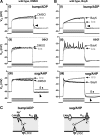
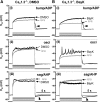
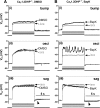
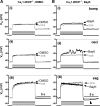

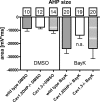

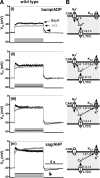
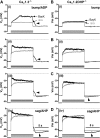
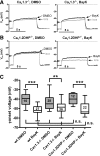
Similar articles
-
Cav 1.3 channels play a crucial role in the formation of paroxysmal depolarization shifts in cultured hippocampal neurons.Epilepsia. 2017 May;58(5):858-871. doi: 10.1111/epi.13719. Epub 2017 Mar 11. Epilepsia. 2017. PMID: 28295232 Free PMC article.
-
Dynamic interplay of excitatory and inhibitory coupling modes of neuronal L-type calcium channels.Am J Physiol Cell Physiol. 2011 Apr;300(4):C937-49. doi: 10.1152/ajpcell.00219.2010. Epub 2011 Jan 12. Am J Physiol Cell Physiol. 2011. PMID: 21228322 Free PMC article.
-
The L-type calcium channel Cav1.3 is required for proper hippocampal neurogenesis and cognitive functions.Cell Calcium. 2015 Dec;58(6):606-16. doi: 10.1016/j.ceca.2015.09.007. Epub 2015 Oct 3. Cell Calcium. 2015. PMID: 26459417
-
The role of L-type voltage-gated calcium channels Cav1.2 and Cav1.3 in normal and pathological brain function.Cell Tissue Res. 2014 Aug;357(2):463-76. doi: 10.1007/s00441-014-1936-3. Epub 2014 Jul 5. Cell Tissue Res. 2014. PMID: 24996399 Review.
-
CaV1.3 as pacemaker channels in adrenal chromaffin cells: specific role on exo- and endocytosis?Channels (Austin). 2010 Nov-Dec;4(6):440-6. doi: 10.4161/chan.4.6.12866. Epub 2010 Nov 1. Channels (Austin). 2010. PMID: 21084859 Review.
Cited by
-
Role of CACNA1C gene polymorphisms and protein expressions in the pathogenesis of schizophrenia: a case-control study in a Chinese population.Neurol Sci. 2017 Aug;38(8):1393-1403. doi: 10.1007/s10072-017-2963-0. Epub 2017 Jun 7. Neurol Sci. 2017. PMID: 28593527
-
Cav 1.3 channels play a crucial role in the formation of paroxysmal depolarization shifts in cultured hippocampal neurons.Epilepsia. 2017 May;58(5):858-871. doi: 10.1111/epi.13719. Epub 2017 Mar 11. Epilepsia. 2017. PMID: 28295232 Free PMC article.
-
The Role of Calcium and Iron Homeostasis in Parkinson's Disease.Brain Sci. 2024 Jan 17;14(1):88. doi: 10.3390/brainsci14010088. Brain Sci. 2024. PMID: 38248303 Free PMC article. Review.
-
Preventing diabetic retinopathy by mitigating subretinal space oxidative stress in vivo.Vis Neurosci. 2020 Jun 15;37:E002. doi: 10.1017/S0952523820000024. Vis Neurosci. 2020. PMID: 32536351 Free PMC article. Review.
-
Regulation of Postsynaptic Stability by the L-type Calcium Channel CaV1.3 and its Interaction with PDZ Proteins.Curr Mol Pharmacol. 2015;8(1):95-101. doi: 10.2174/1874467208666150507103716. Curr Mol Pharmacol. 2015. PMID: 25966696 Free PMC article. Review.
References
-
- Amano H, Amano T, Matsubayashi H, Ishihara K, Serikawa T, Sasa M. Enhanced calcium influx in hippocampal CA3 neurons of spontaneously epileptic rats. Epilepsia 42: 345–350, 2001 - PubMed
-
- Barad M. Later developments: molecular keys to age-related memory impairment. Alzheimer Dis Assoc Disord 17: 168–176, 2003 - PubMed
-
- Cai X, Liang CW, Muralidharan S, Kao JP, Tang CM, Thompson SM. Unique roles of SK and Kv4.2 potassium channels in dendritic integration. Neuron 44: 351–364, 2004 - PubMed
Publication types
MeSH terms
Substances
LinkOut - more resources
Full Text Sources
Other Literature Sources
Miscellaneous

